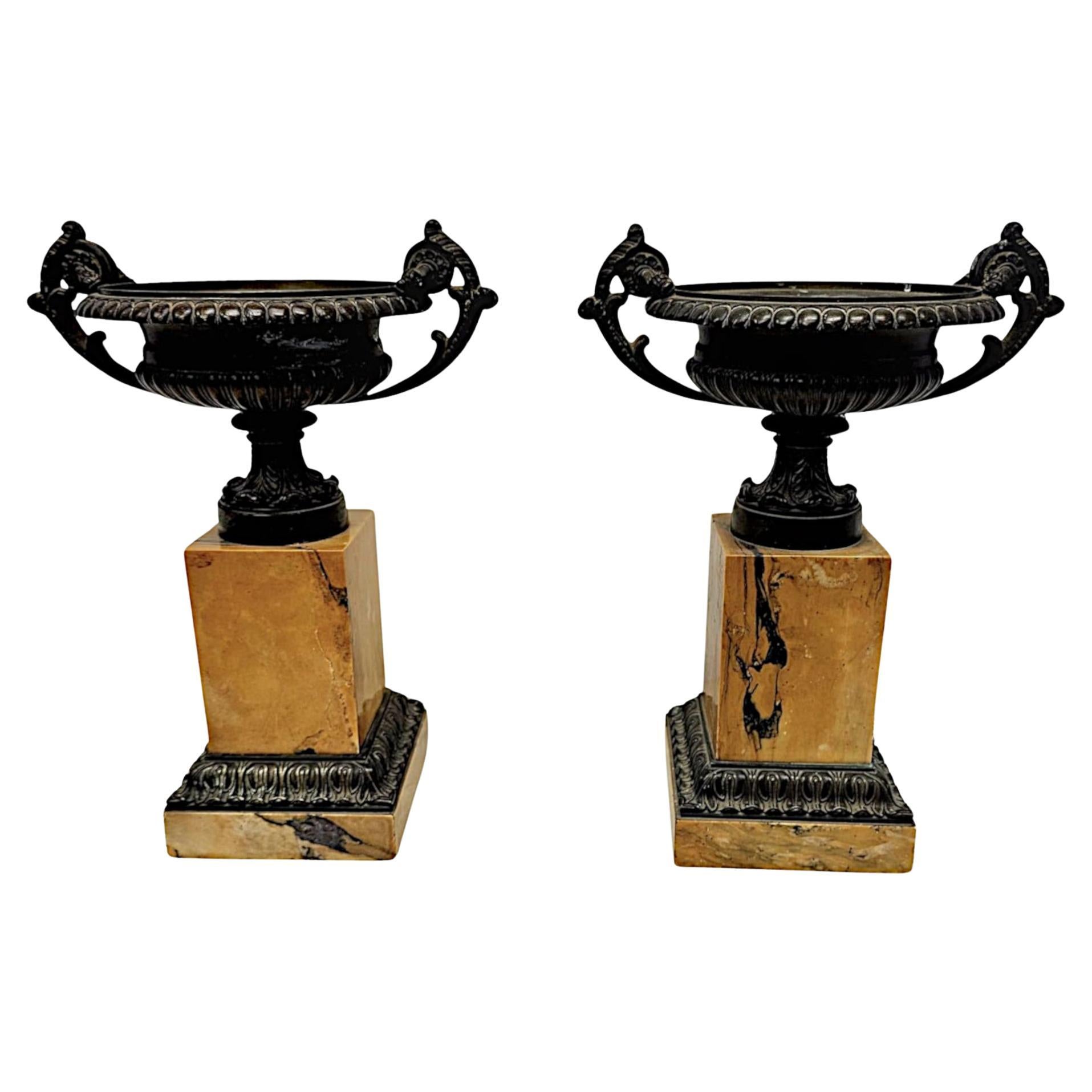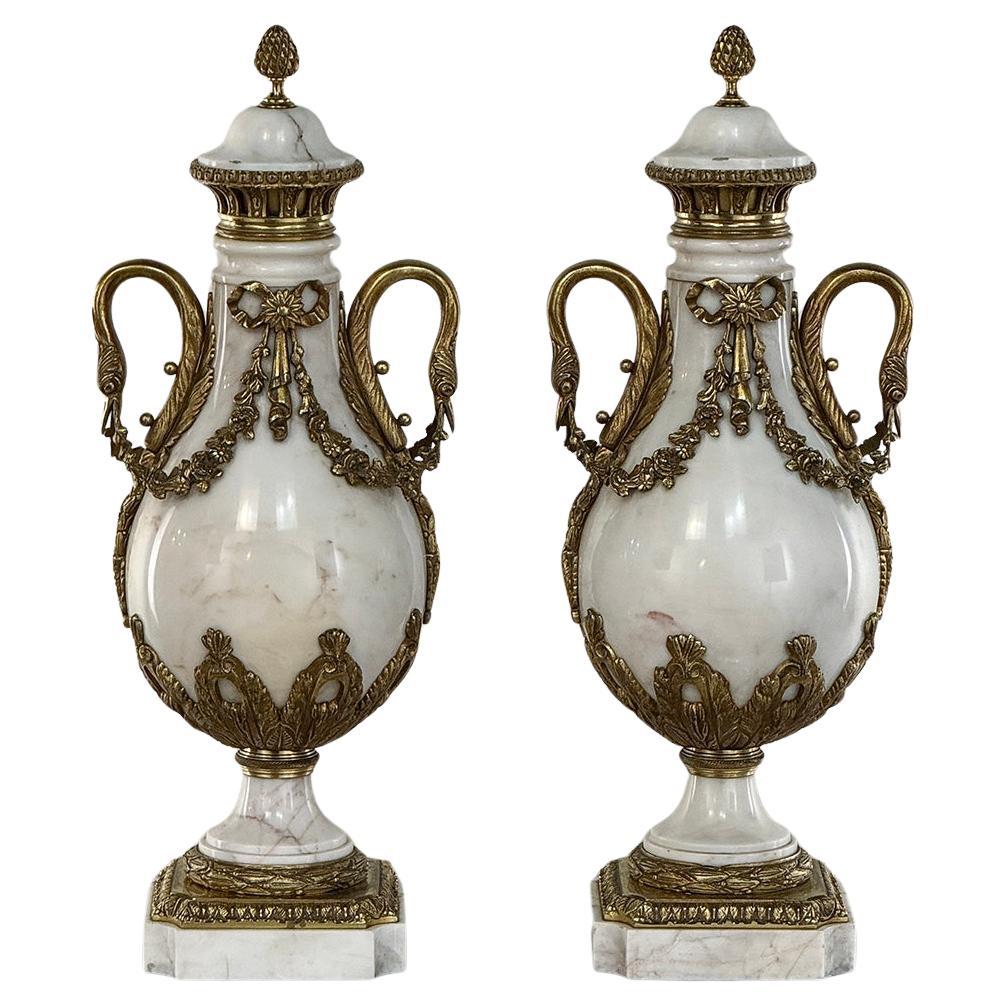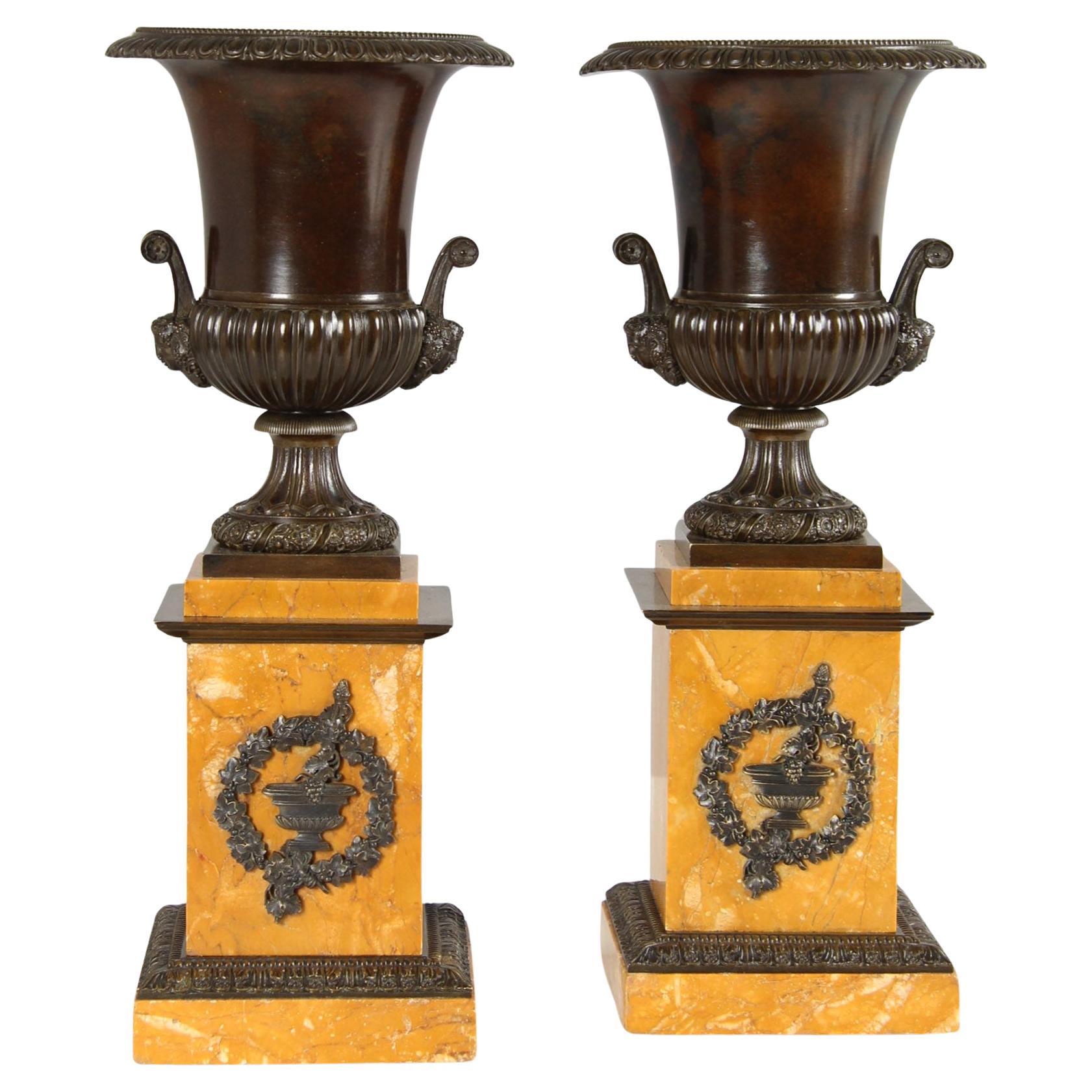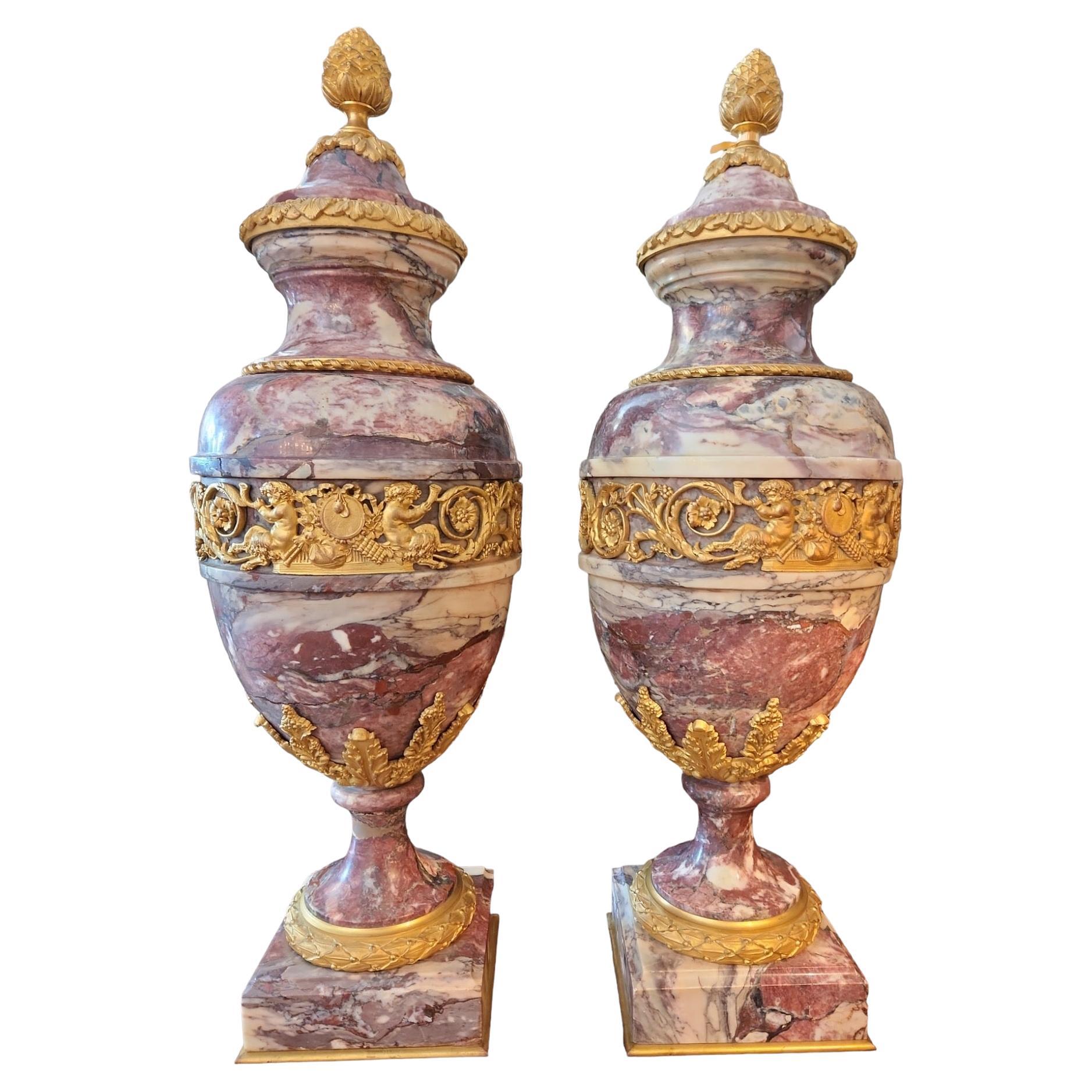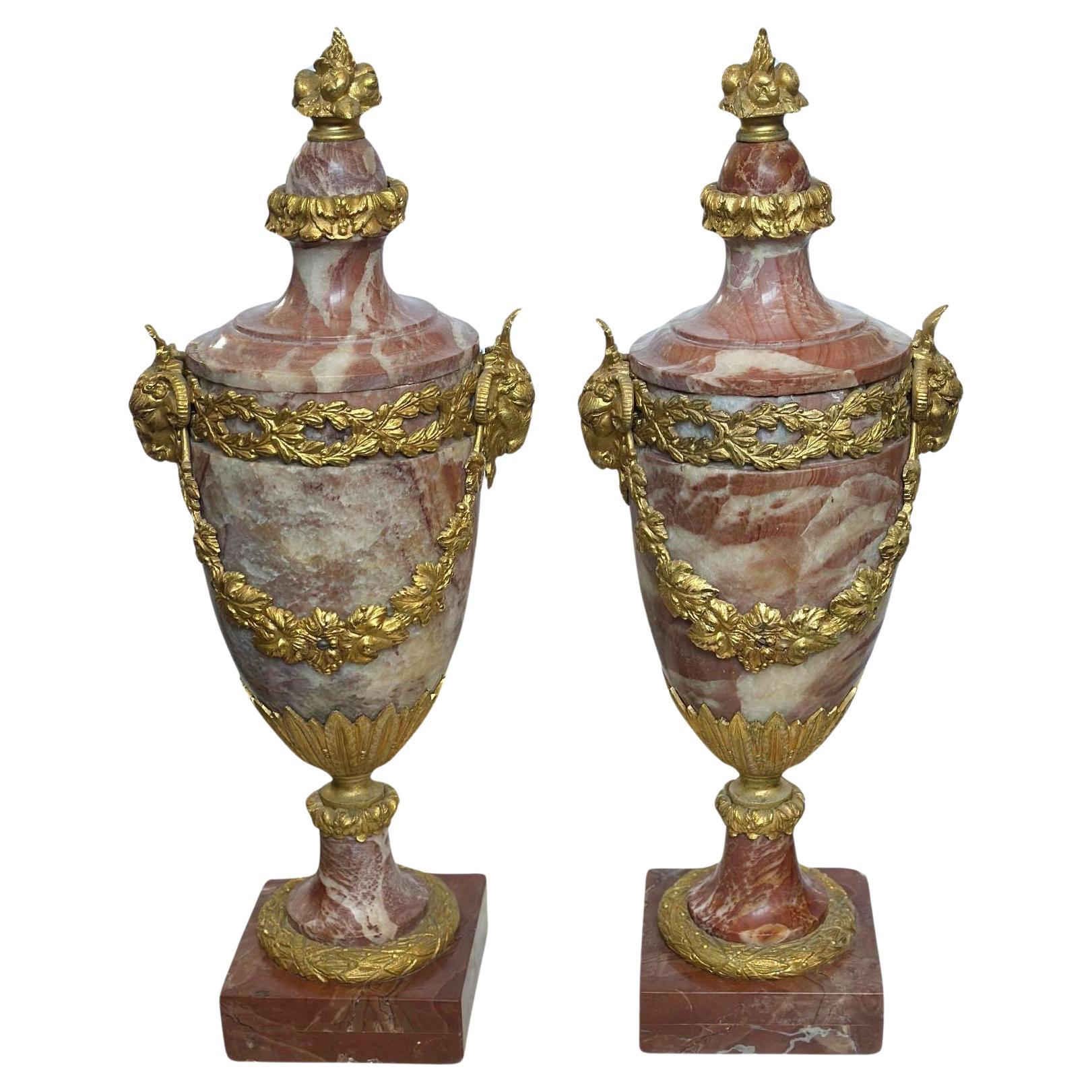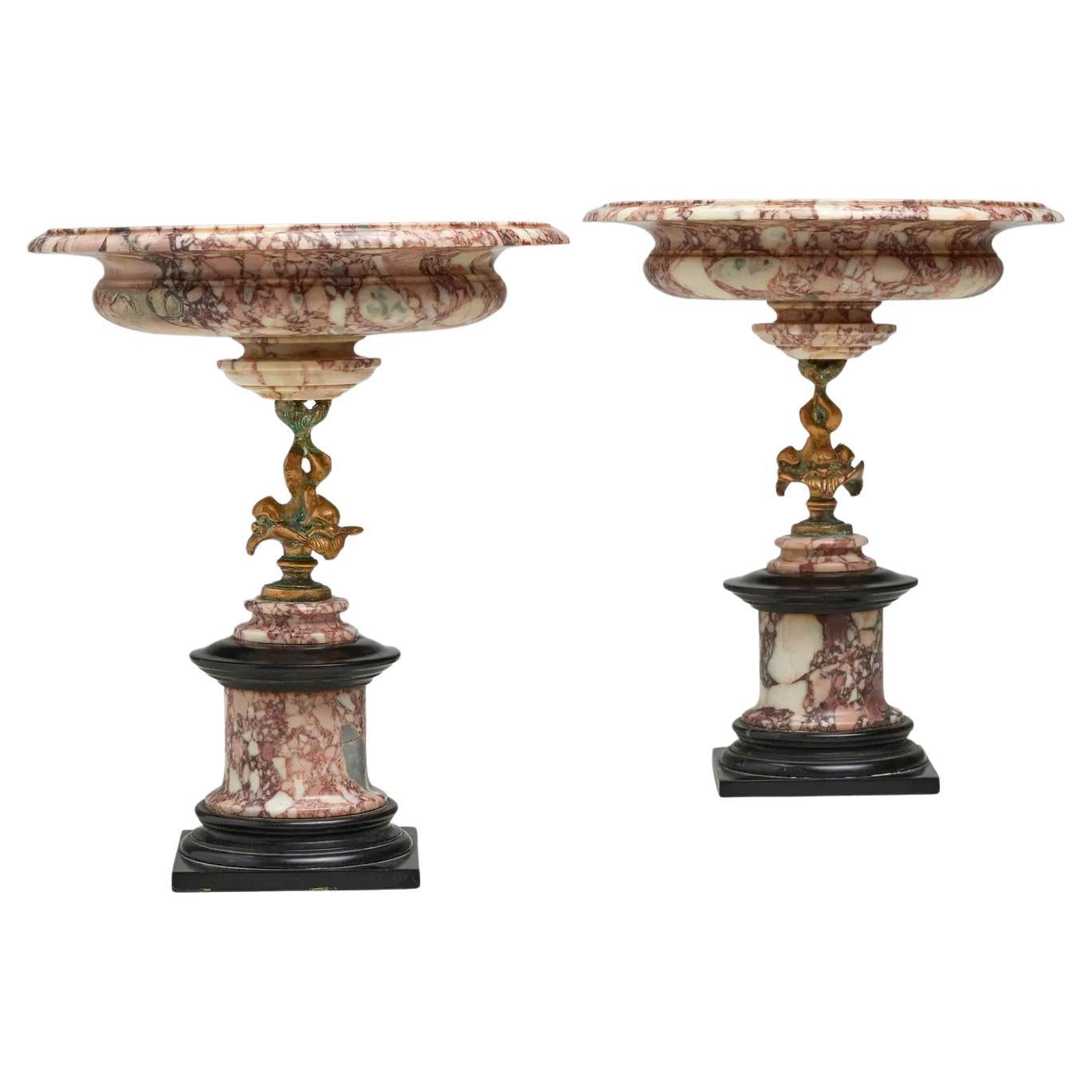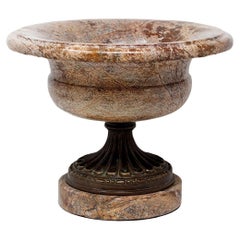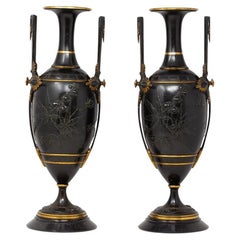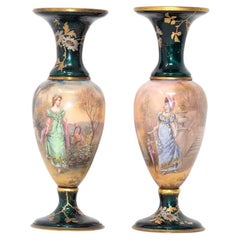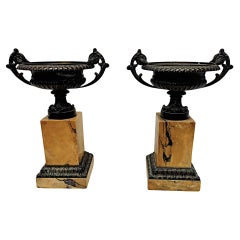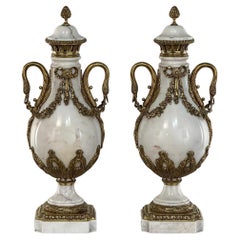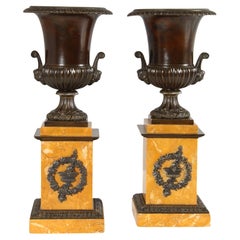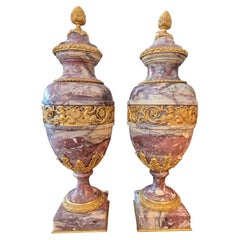Items Similar to French Antique Siena Marble and Bronze Tazza Urns
Want more images or videos?
Request additional images or videos from the seller
1 of 13
French Antique Siena Marble and Bronze Tazza Urns
$7,451.71
£5,500
€6,435.55
CA$10,265.23
A$11,496.41
CHF 5,998.64
MX$140,423.66
NOK 76,320.11
SEK 71,940.85
DKK 48,027.75
About the Item
Applied Lyre Decoration
From our Decorative collection, we are delighted to offer this pair of fabulous French Siena Marble Tazza Urns. The pair of Tazza Urns stood upon four cast Bronze feet with a pedestal Siena Marble foot with an applied bronze scrollwork border. The central square column with a bronze Swan neck lyre harp bordered by floral swags to the front of the vase. The base of each Tazza Urn cast in Bronze with Ram’s head twin loop handles and a floral band surmounted by a tapered Siena Marble Core finished with a Bronze liner. The Tazza Urns dating to the first half of the 19th century during the latter reign of Charles X circa 1830.
Bronze an alloy consisting primarily of copper with approximately 12–12.5% tin and often with the addition of other metals (including aluminium, manganese, nickel, or zinc) and sometimes non-metals, such as phosphorus, or metalloids such as arsenic or silicon depending on the age of the bronze and its origin. The additions of other metals produce a range of alloys that are usually harder than copper alone and carry useful properties such as strength. The earliest known use of bronze dates to the 5th millennium BCE from Iranian plateau, the bronze mix consists of arsenical copper and copper-arsenide. The earliest tin-copper-alloy recovered is dated to circa 4650 BCE and was found in Plocnik, Serbia. It is believed to have been smelted from a natural tin-copper ore.
Sienna Marble consists of various dark yellow and gold colours, it is extremely heterogeneous due to the presence of grains with shades ranging from ivory white to light yellow to a reddish yellow ocher and is usually an intense marble.
Lyre a stringed musical instrument part of the lute-family and consists of two arms and a crossbar with strings. The Lyre has featured on classical objects like the pair of vases above for thousands of years. They were commonly used in several ancient cultures surrounding the Mediterranean Sea. The earliest known examples of the lyre have been recovered at archaeological sites that date to c. 2700 BCE in Mesopotamia.
Charles X (Charles Philippe 1757-1836) was the King of France during a short reign between 1824 to 1830. He was the uncle of the uncrowned Louis XVII and younger brother to reigning kings Louis XVI and Louis XVIII, he supported the latter in exile. After the Bourbon Restoration in 1814, Charles (as heir-presumptive) became the leader of the ultra-royalists which was a radical monarchist faction within the French court. The ultra-royalists declared absolute monarchy by divine right and opposed the constitutional monarchy concessions towards liberals and the guarantees of civil liberties granted by the Charter of 1814. Charles gained influence after the shocking assassination of his son Charles Ferdinand, Duke of Berry, in 1820. Charles went on to succeed his brother Louis XVIII in 1824 to become the King of France.
His reign of almost six years proved to be deeply unpopular amongst the liberals in France from the moment of his coronation in 1825, in which he tried to revive the practice of the royal touch. Throughout his short lived reign Charles remained unpopular and tried various methods to deter the spotlight such as the conquest of Algeria and forcing Haiti to pay a hefty indemnity in return for lifting a blockade and recognising Haiti’s independence. Eventually the Charles was abdicated, and Louis Philippe I became the King of the French. Charles was exiled and died in 1836 in Gorizia, then part of the Austrian Empire. He was the last of the French rulers from the senior branch of the House of Bourbon.
- Dimensions:Height: 18.12 in (46 cm)Diameter: 7.88 in (20 cm)
- Style:Charles X (Of the Period)
- Materials and Techniques:
- Place of Origin:
- Period:
- Date of Manufacture:Circa 1830
- Condition:Wear consistent with age and use. Minor losses. Excellent, untouched condition, very minor nibbles to the marble extremities.
- Seller Location:Newark, GB
- Reference Number:Seller: BRDD1stDibs: LU6971245210842
About the Seller
5.0
Gold Seller
Premium sellers maintaining a 4.3+ rating and 24-hour response times
Established in 2019
1stDibs seller since 2022
37 sales on 1stDibs
Typical response time: 2 hours
- ShippingRetrieving quote...Shipping from: Newark, United Kingdom
- Return Policy
Authenticity Guarantee
In the unlikely event there’s an issue with an item’s authenticity, contact us within 1 year for a full refund. DetailsMoney-Back Guarantee
If your item is not as described, is damaged in transit, or does not arrive, contact us within 7 days for a full refund. Details24-Hour Cancellation
You have a 24-hour grace period in which to reconsider your purchase, with no questions asked.Vetted Professional Sellers
Our world-class sellers must adhere to strict standards for service and quality, maintaining the integrity of our listings.Price-Match Guarantee
If you find that a seller listed the same item for a lower price elsewhere, we’ll match it.Trusted Global Delivery
Our best-in-class carrier network provides specialized shipping options worldwide, including custom delivery.More From This Seller
View AllFrench Champleve and Onyx Urns Barbedienne
By Ferdinand Barbedienne
Located in Newark, England
Onyx & Champleve Enamel
From our Decorative collection, we are delighted to offer this pair of French Champleve and Onyx Urns attributed to Barbedienne. The Urns of typical form wi...
Category
Antique Late 19th Century French Belle Époque Urns
Materials
Onyx, Bronze, Enamel, Ormolu
Grand Tour Marble and Bronze Tazza Urn Centrepiece
Located in Newark, England
Bronze Cast Stem
From our Decorative collection we are pleased to offer this Grand Tour Sarrancolin Marble Tazza Urn. The Grand Tour Tazza Urn of typical form composed from Sarranco...
Category
Antique Late 19th Century French Grand Tour Centerpieces
Materials
Marble, Bronze
French Aesthetic Movement Bronze Vases
By Ferdinand Barbedienne
Located in Newark, England
Decorated with Insects
From our Decorative collection, we are delighted to offer a pair of French Aesthetic Movement Bronze Vases. The Frenc...
Category
Antique Late 19th Century French Aesthetic Movement Vases
Materials
Slate, Bronze, Ormolu
Antique French Pair of Limoges Enamel Vases
By Limoges
Located in Newark, England
Belle Epoque Circa 1880
From our Decorative collection, we are pleased to offer this pair of Antique French Limoges Enamel Vases. The French Lim...
Category
Antique Late 19th Century French Belle Époque Vases
Materials
Metal, Enamel
French Sevres Château de Fontainebleau Porcelain Serving Dishes
By Manufacture Nationale de Sèvres
Located in Newark, England
Ormolu Mounted
From our Ceramics collection, we are delighted to offer a pair of French Sevres boat-shaped porcelain dishes with original ormolu mounts. The serving dishes beautifully decorated with a frieze of vibrant green undulating foliate garlands interspersed with mosaic style classical romanesque cartouches and birds. The inside decorated with gilt scrollwork embellishments with a six point start to the centre. The porcelain raised on four scrolling legs draped with garlands of fruiting vine. The porcelain bearing the Louis Philippe interlaced L's Sevres mark, the Chateau de Fontainebleau mark, incised marks for the original serves blank manufacturing along with initials and finally the painted initials WB. The dishes dated to the first half of the 19th century 1839/1840 respectively. The ormolu mounts stamped to the base CHER.
Château de Fontainebleau (also known as the Palace of Fontainebleau) is located southeast of Paris and is one of the largest French royal châteaux. The medieval castle served as a residence for the French monarchs from Louis VII...
Category
Antique Mid-19th Century French Louis Philippe Ceramics
Materials
Ormolu
French Pair of Louis XIV Style Ormolu Candelabra Henry Dasson
By Henry Dasson
Located in Newark, England
French Late Bronze Dore
From our Decorative collection, we are delighted to introduce this French Pair of Louis XIV Style Ormolu Candelabra by Henry Dasson. The pair of candelabra b...
Category
Antique Late 19th Century French Louis XIV Candelabras
Materials
Metal, Bronze, Ormolu
You May Also Like
A Very Rare Pair of 19th Century Bronze and Sienna Marble Tazza Urns
Located in Dublin, IE
A very rare pair of 19th Century finely cast bronze tazza urns of exceptional quality and grand proportions. The urns of circular form with decorative sphere motif detail to the eve...
Category
Antique 19th Century French Urns
Materials
Siena Marble, Bronze
Pair Antique French Empire Cararra Marble and Bronze Cassolettes ~ Mantel Urns
Located in Dallas, TX
Pair Antique French Empire Cararra Marble and Bronze Cassolettes ~ Mantel Urns will make a stunning visual accent for any room! Hand-crafted from prized Carrara marble and gold-plat...
Category
Early 20th Century French Empire Urns
Materials
Carrara Marble, Bronze
Pair of Mid 19th Century Medici-Vases, Patinated Bronze, Siena Marble, c. 1840
Located in Greven, DE
Pair of antique Medici vases
France
Bronze, marble
Mid 19th century
Dimensions: H x W x D: 37 x 12 x 12 cm
Description:
Beautiful and well-preserved pair of Medici vases in the style of Grand Tour objects.
Each with a three-part pedestal made of Siena marble. Above the wider base we see a surrounding frieze of leaves and flowers on which the stele rests. A tazza vase...
Category
Antique Mid-19th Century French Charles X Vases
Materials
Siena Marble, Bronze
19th Century French Bronze-Mounted Marble Urns
Located in Los Angeles, CA
The finest of bronze castings. Lids are attached. The base is 6" x 6".
Category
Antique Late 19th Century French Neoclassical Urns
Materials
Marble, Bronze
$12,500 / set
Pair of French Late 19th Century Marble & Bronze Urns
Located in Los Angeles, CA
A pair of beautiful urn vases made of rich veined marble and ormolu bronze mounts all around the piece. They are each standing on a squared marble base. The urns have two detailed mo...
Category
Antique Late 19th Century French Urns
Materials
Marble, Bronze
A Pair of Grand Tour Neoclassical Tazze Marble and Patinated Bronze
Located in Wiscasset, ME
A nice pair of mid-19th century Grand Tour tazze or marble and patinated bronze.
7½ h × 6 dia in each
In very good condition and ready to display.
Category
Antique Mid-19th Century Italian Grand Tour Garniture
Materials
Marble, Bronze
